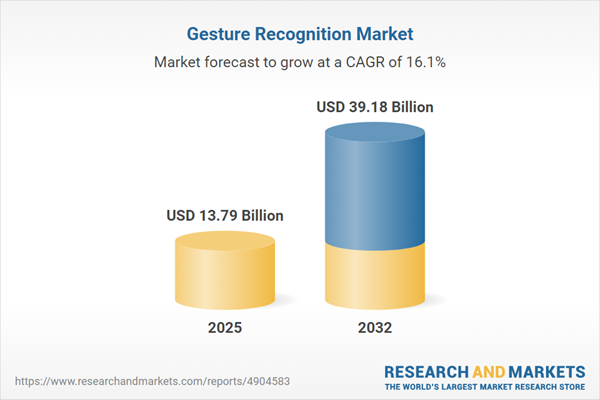Speak directly to the analyst to clarify any post sales queries you may have.
Gesture recognition technology is driving a shift in enterprise user interfaces by supporting contactless and efficient work environments. This report addresses strategic considerations for organizations aiming to implement gesture-based solutions that meet evolving compliance requirements and productivity demands.
Market Snapshot: Gesture Recognition Market Size and Outlook
The global gesture recognition market is valued at USD 11.89 billion in 2024 and is expected to reach USD 13.79 billion by 2025, with projections estimating the market will rise to USD 39.18 billion by 2032. This growth occurs at a CAGR of 16.06%, as industry adoption accelerates across key sectors such as automotive, healthcare, and consumer electronics. Organizations are leveraging gesture recognition to address needs for non-contact interfaces, streamline complex workflows, and introduce automation. Integration with machine learning is redefining digital interactions, helping companies realize improved productivity, reduced operational friction, and access to digitally-enabled service innovations.
Scope & Segmentation in the Gesture Recognition Market
- Technology: Solutions including active infrared, capacitive touch, computer vision, radar, and ultrasonic approaches equip enterprises with reliable, context-aware gesture controls adaptable to distinct operational scenarios.
- Product Types: Enterprises deploy sensor devices, specialized software suites, wearable technologies, and next-generation touchless platforms to align with diverse integration strategies and support core business transformations.
- Deployment Modes: Cloud-based and on-premise deployments allow organizations to tailor gesture solutions to their unique security priorities and compliance landscapes, supporting agile IT decision-making.
- Application Areas: Gesture technology powers automotive command interfaces, improves medical device usability, accelerates AR/VR adoption, enhances gaming experiences, and drives industrial automation.
- End User Segments: Businesses are adopting gesture-driven systems to advance transparency and improve workplace safety, while consumers benefit from adaptive, user-centric digital environments that reflect shifting expectations.
- Regional Dynamics: Implementation and adoption rates vary across North America, Latin America, Europe, Middle East, Africa, and Asia-Pacific as organizations navigate regional regulations and market environments.
- Companies Profiled: Major technology leaders—including Microsoft, Google, Apple, Samsung Electronics, Qualcomm, Intel, NVIDIA, Sony, Huawei, and Ultraleap—advance gesture recognition’s capabilities and define new standards for enterprise adoption.
Key Takeaways for Senior Decision-Makers
- Gesture recognition minimizes unnecessary physical interaction in sensitive or regulated workplaces, directly aligning with occupational health and safety objectives.
- Incorporating edge computing and sensor fusion within gesture platforms increases system responsiveness and addresses enterprise needs for robust data privacy in business-critical operations.
- Configurable gesture recognition tools support varying digital maturity levels and facilitate enterprise-wide and multinational compliance, aiding seamless regulatory management.
- Partnering with experienced systems integrators and established technology suppliers optimizes rollouts and accelerates solution adoption, supporting measurable improvements in onboarding and daily operations.
- Implementing sound procurement and inventory management policies mitigates operational risk, building resilience into supply chains and supporting steady organizational performance amid market changes.
Tariff Impact: Effect of 2025 US Tariff Changes on Gesture Recognition Supply Chains
Planned US tariff adjustments are altering enterprise sourcing strategies for gesture recognition components, such as sensor and radar modules. In response, organizations are prioritizing regionalization and domestic production, exploring opportunities for vertical integration to strengthen their supply chains. These measures advance compliance objectives and support consistent component availability as trade regulations continue to evolve across global markets.
Research Methodology & Data Sources
This analysis is grounded in insights from peer-reviewed journals, recognized industry benchmarks, expert whitepapers, targeted industry surveys, and executive-level interviews. Cross-verification of these sources ensures objective and actionable findings tailored to leaders guiding gesture recognition initiatives.
Why This Report Matters for B2B Market Leaders
- Outlines actionable approaches for entering emerging segments, benchmarked investment evaluation, and integration of gesture recognition into established enterprise ecosystems.
- Supports supply chain optimization and compliance management across dynamic regional and global regulatory landscapes.
- Delivers a structured roadmap for scalable deployment and long-term operational gains through advanced technology adoption.
Conclusion
Adopting gesture recognition positions organizations to enhance security, automation, and flexibility in digital operations. This report gives leaders the strategic direction for leveraging future-focused technologies and sustaining compliance within rapidly evolving markets.
Additional Product Information:
- Purchase of this report includes 1 year online access with quarterly updates.
- This report can be updated on request. Please contact our Customer Experience team using the Ask a Question widget on our website.
Table of Contents
3. Executive Summary
4. Market Overview
7. Cumulative Impact of Artificial Intelligence 2025
Companies Mentioned
The companies profiled in this Gesture Recognition market report include:- Microsoft Corporation
- Google LLC
- Apple Inc.
- Samsung Electronics Co., Ltd.
- Qualcomm Technologies, Inc.
- Intel Corporation
- NVIDIA Corporation
- Sony Corporation
- Huawei Technologies Co., Ltd.
- Ultraleap Limited
Table Information
| Report Attribute | Details |
|---|---|
| No. of Pages | 193 |
| Published | October 2025 |
| Forecast Period | 2025 - 2032 |
| Estimated Market Value ( USD | $ 13.79 Billion |
| Forecasted Market Value ( USD | $ 39.18 Billion |
| Compound Annual Growth Rate | 16.0% |
| Regions Covered | Global |
| No. of Companies Mentioned | 11 |









